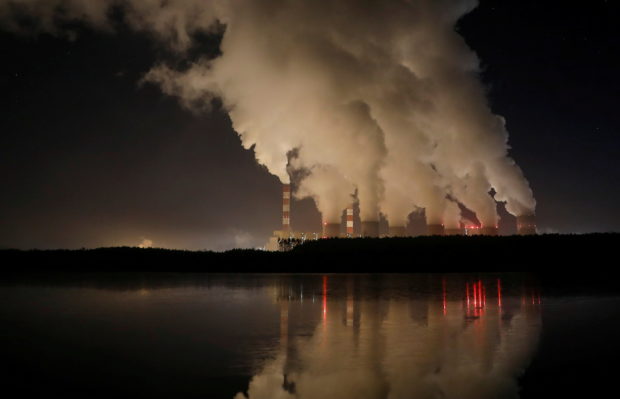
FILE PHOTO: Smoke and steam billows from Belchatow Power Station, Europe’s largest coal-fired power plant operated by PGE Group, at night near Belchatow, Poland December 5, 2018. Picture taken December 5, 2018. REUTERS/Kacper Pempel/File Photo
BRUSSELS — The European Union will unveil on Wednesday its most ambitious plan yet to tackle climate change, aiming to pull ahead in the race among the world’s biggest economies to turn far-off green goals into concrete action this decade.
The European Commission, which drafts EU policies, will set out in painstaking detail how the bloc’s 27 countries can meet their collective goal to net reduce greenhouse gas emissions by 55% from 1990 levels by 2030.
That is expected to mean raising the cost of emitting carbon for heating, transport and manufacturing, taxing high-carbon aviation and shipping fuels that have not been taxed before, and charging importers at the border for carbon they emitted to make products such as cement and steel abroad.
“It’s going to be the biggest climate package in our history,” said Jytte Guteland, the Swedish lawmaker who was European Parliament’s lead negotiator on the EU’s climate targets. “Our economic sectors, our industries, everyone has to adapt to something new.”
The measures will require approval by member states and the European parliament. They are likely to face intense lobbying from some industrial sectors, from poorer European member states who want to protect their citizens from price hikes, and from higher polluting countries facing a more costly transition.
A diplomat from one EU country said the success of the package would rest on its ability to be “realistic” and socially fair, while not destabilising the economy.
“The aim is to put the economy on a new level, not to stop it,” the diplomat said.
Now the hard part
The EU package arrives days after California suffered one of the highest temperatures ever recorded on earth, the latest in a torrent of brutal heatwaves that have hit Russia, Northern Europe and Canada.
The EU has so far cut emissions by 24% from 1990 levels, but many of the simplest steps, such as reducing reliance on coal to generate power, have been taken already. Hitting targets over the next decade will require bigger adjustments.
As climate change impacts worsen around the world, Brussels will propose 12 policies to take aim at most big sources of emissions, including power plants, factories, cars, planes and heating systems in buildings.
The measures follow a core principle: make polluting more expensive and green options more attractive to the EU’s 25 million businesses and nearly half a billion people.
The raft of proposals is expected to include tougher EU targets to expand renewable energy and cut energy consumption by renovating buildings this decade.
Planes, ships and automobiles
Tighter emission limits for cars are expected to end new petrol and diesel car sales by 2035 or 2040 in the EU.
An overhaul of the EU emissions trading system, the biggest carbon market in the world, would force factories, power plants and airlines to pay more when they emit CO2. Ships could also be added to the ETS, forcing shipowners to pay for their pollution for the first time.
A new EU carbon market is expected to impose CO2 costs on the transport and buildings sectors – with some of the revenues put in a fund to curb low-income households’ fuel bills.
The Commission will also unveil its plan for the world’s first “carbon border tariff,” requiring manufacturers abroad to pay CO2 costs when they sell goods such as steel and cement into the EU.
Meanwhile, a tax overhaul could impose an EU-wide tax on polluting aviation fuels, which currently dodge such levies.
For some EU countries, the package is a chance to cement the EU’s global leadership in fighting climate change.
Danish climate and energy minister Dan Jorgensen said it would signal to the rest of the world that “it is possible to both set ambitious goals and introduce the concrete necessary measures to reach them.”
But the plans have exposed familiar rifts between EU countries. Poorer member states are wary of policies that would raise consumer costs, while regions that depend on coal power plants and mines want guarantees of more support as they brace for a transformation that will require mass retraining of workers.